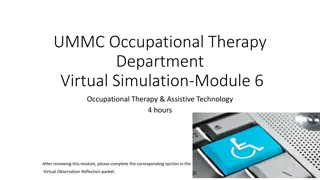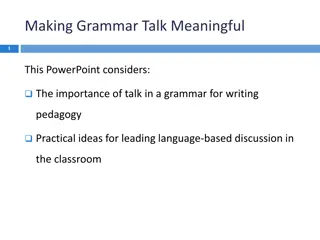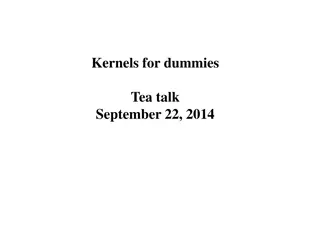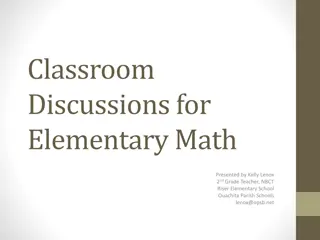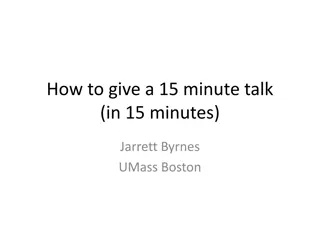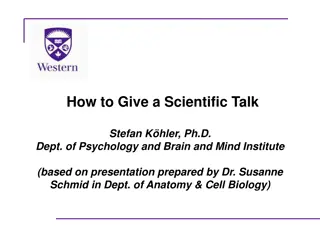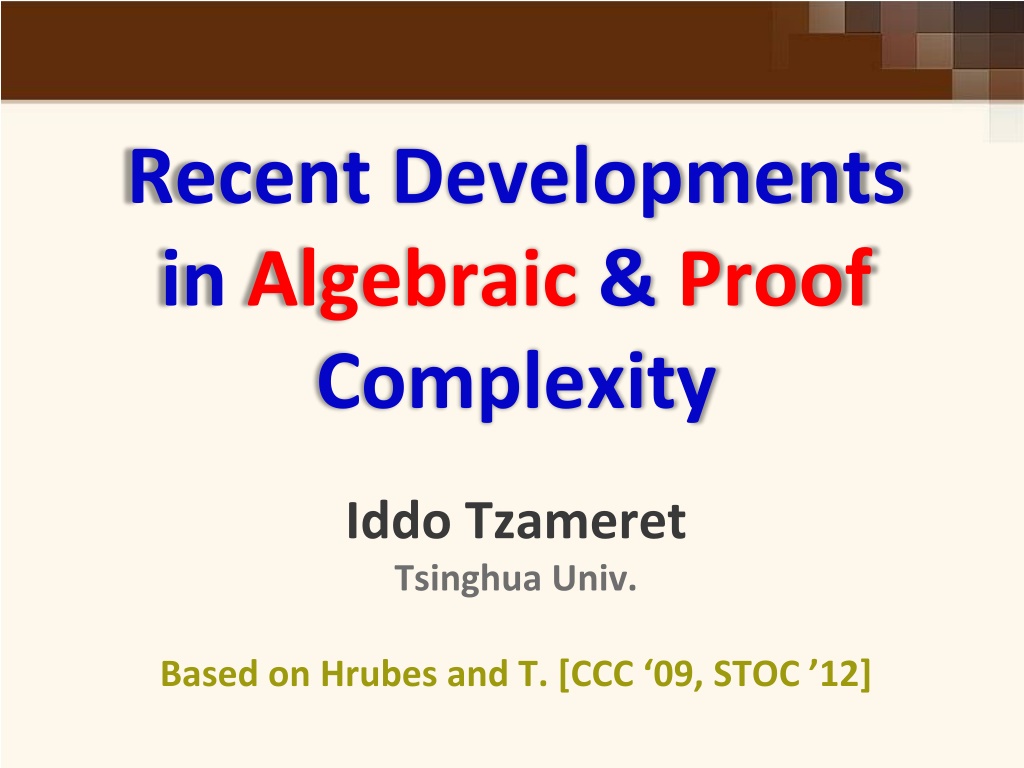
Recent Developments in Algebraic & Proof Complexity: Propositional Proofs and Circuit-Based Approaches
Explore recent advancements in algebraic proof complexity, including propositional proofs and circuit-based approaches. Delve into the complexity of proofs, fundamental open problems in logic, and connections to efficient computations. Discover the Frege hierarchy and a case study on linear algebra within NC2.
Download Presentation

Please find below an Image/Link to download the presentation.
The content on the website is provided AS IS for your information and personal use only. It may not be sold, licensed, or shared on other websites without obtaining consent from the author. Download presentation by click this link. If you encounter any issues during the download, it is possible that the publisher has removed the file from their server.
E N D
Presentation Transcript
Recent Developments in Algebraic & Proof Complexity Iddo Tzameret Tsinghua Univ. Based on Hrubes and T. [CCC 09, STOC 12]
Propositionalproofs Take any standard textbook proof systems: Frege, sequent calculus, Hilbert style, Natural deduction It doesn t matter! 2
Example of propositional proof A A axiom B B F F X (A A) B (B B) A (B A) B commutativity (A B) A F X F Y F (X Y) (A B) ( A B) 3
Complexity of proofs Size of proof = number of symbols it takes to write down the proof (= total size of all formulas in proof) Example: Size: 41 Fact: Every two Frege/sequent-proofs are polynomially equivalent!
Complexity of Proofs Fundamental open problem in logic & complexity: Prove super-polynomial lower bounds on propositional proofs! Prove that there is a family {f1,f2,f3, } of tautologies s.t. for no polynomial p( ): MinProofSize(fi) p(|fi|)
Complexity of Proofs Motivation: 1. Advance towards NP coNP 2. SAT solving 3. Connections between efficient proofs and efficient computations Computing functions (e.g., determinants) Proving statements (e.g., properties of determinants)
Circuit based proofs Think of every proof-line as a circuit: NC1 circuits: poly(n) size, O(log n) depth NC1-Frege (=Frege): proof-lines are formulas NC2 circuits: poly(n) size, O(log2n) depth NC2-Frege: O(log2n) depth proof-lines P/poly circuits: poly(n) size P/poly-Frege (=eFrege): proof-lines are circuits
Frege Hierarchy P/poly-Frege all proof lines are circuits NC2-Frege all proof lines are depth O(log2(n)) circuits NC1-Frege all proof lines are depth O(log(n)) circuits= formulas Useful analogy; understand the Frege hierarchy: lower/upper bounds
Case study: linear algebra Determinant in NC2 Can we prove properties of determinant with poly-size NC2-Frege proofs ? Conjecture: Yes! (Cook; Rackoff; Bonet, Buss & Pitassi; Soltys) Specifically: AB=I BA=I has no short NC1-proofs Previous work: Soltys and Cook ( 04): poly-size P/poly-Frege proofs
Case study: linear algebra Determinant conjectured not in NC1 Conjecture: Properties of determinant outside poly-size NC1-Frege proofs.
Algebraic circuits Fix a field F An algebraic circuit over F computes a formal polynomial over F output + + 3 x1 x2 (x1+x2) (x2+3)= x1x2+x22+3x1+3x2 Size = number of nodes
Proof systems in the algebraic world? Proofs of polynomial identities: For F,G algebraic circuits E.g.: (x1+x2) (x2+3) = x1x2+x2x2+3x1+3x2 BPP language (unlike TAUT in coNP) Note: not (algebraic) propositional proofs! F=G
Proof-lines: equations between algebraic circuits Axioms: polynomial-ring axioms; f+g=g+f, etc. Rules: Transitivity of = ; +,x introduction, etc. Circuit-axiom: F=G, if F and G are identical when the circuits unwinded into trees Start from axioms and derive new identities by derivation rules: 3x 2=2 3x axiom x=x reflexivity axiom 2 3=6 field identities axiom product rule commutativity 2 3x=6x transitivity 3x 2=6x
Relations to polynomial identity testing We shall see: Relations to propositional proofs!
[Hrubes, T. CCC 09]: Proof-lines: equations between formulas (and more restricted circuits): Short Bounded depth proofs for interesting families of polynomial identities: Symmetric polynomials; Vandermonde matrices identities Lower bounds on very restrictive proofs
[Hrubes, T. STOC 12]: Proof-lines: equations between circuits Structural results for algebraic circuits carry over to arithmetic proofs 1. Eliminate high degrees (Strassen '73) 2. Division elimination (Strassen '73, Hrube , Yehudayoff '11) 3. Arithmetic-P/poly = Arithmetic-NC2 (Valiant, Skyum, Berkowitz and Rackoff '83)
Syntactic-degree of G: expand all terms in G, without canceling terms! Syntactic-degree = maximal degree of a term. Example: x(1+y50)-xy50 Expansion: x+xy50-xy50 Syntactic-degree: 51
Thm: Let G,F be of syntactic-degree d. Then proving G=F using proof-lines with syntactic- degrees higher than d cannot help reducing size. Example: for proving x(1+y50)-xy50=x, terms with degree 51 won t help!
We can extend our language to have division gates (apart from +,x): f/g computes the rational function f/g. We add the axiom: f f-1=1, for any f 0; We call the resulting proof: proof with division Thm: Assume F=G is true identity without division gates. Then any proof with division of F=G can be transformed into a proof of F=G without divisions, with only polynomial increase in size.
Balancing circuits (Valiant et al.): G a circuit with size s and degree poly(n) into circuits [G] of size poly(s) and depth O(log2n) (computing same polynomial) can transform G Balancing proofs: F,G: circuits with syntactic-degree poly(n). Then, poly(n)- size arithmetic proof of F=G transforms into poly(n)-size and O(log2n)- depth arithmetic proof of [F]=[G].
Recall question: Can we prove properties of determinant with poly-size NC2-Frege proofs ? Now we can answer yes ..
(Hrubes T. 2012): Arithmetic proofs of: Det(A) Det(B)=Det(A B) Det(C)=c11 c22 cnn for any A,B,C nxn matrices and Det( ) the determinant function, and C triangular These are poly(n) size proofs operating with equalities between algebraic circuits of O(log2n)-depth Corollary: short propositional NC2-Frege proofs
Arithmetic Proofs are also propositional proofs (over GF(2)) Propositional proofs Arithmetic proofs (over GF(2))
Construction of proofs Construct circuits w/ division gates for inverse and determinant in block forms (gives poly-size circuits):
Construction of proofs Prove statement about X-1 and DET where: 1. Divisions gates allowed 2. Circuits have no depth bound
Structure of argument Arithmetic proofs with division gates Define DET naturally there Homogenization: Eliminate high degree terms from proofs Prove properties of DET Eliminate division gates from proofs Balance the circuits in proofs: O(log2n)-depth NC2-Frege: Transform balanced proofs into propositional proofs (immediate)
Open problem Uniform proofs of linear algebra! Use the arithmetic setting to derive new upper/lower bounds for propositional proofs?






